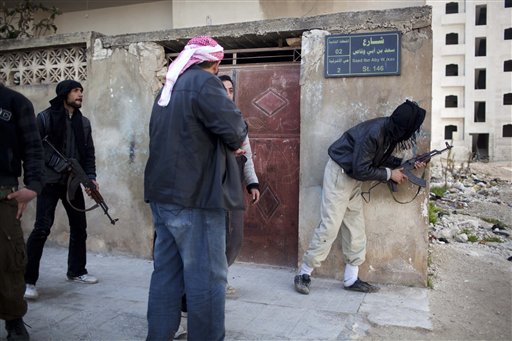
Despite the Obama administration’s predictions that the Syrian government’s days are numbered, recent U.S. intelligence reports suggest President Bashar Assad commands a formidable army that is unlikely to turn on him, an inner circle that has stayed loyal and an elite class that still supports his rule.
The assessment hinted at a continuing campaign lasting several months, if not longer, with more Syrians dying. For the past year, Assad’s government has tried to crush a popular uprising inspired by the Arab Spring movements. The U.N. says more than 7,500 people have died.
Over time, worsening economic conditions could threaten Assad’s hold on power. Food prices recently doubled, unemployment is rising and refined fuel products are running out.
But no mass protests over food or fuel shortages have broken out, and there hasn’t been any discernible slowing in military activity because of a lack of supplies, three senior intelligence officials said Friday. They spoke on condition of anonymity to provide a snapshot of recent intelligence reports and analysis of the crisis.
Satellite imagery shows a new ferociousness to the government’s attacks, including artillery shelling of mosques, schools, playgrounds and a hospital, in the Sunni neighborhood of Homs, the officials said.
Assad’s forces mounted a new assault Saturday on the northern region of Idlib, one of the centers of the uprising against the president. The military operation has raised fears of a new all-out offensive like the siege last month that captured Homs.
The army’s campaigns have driven 2,000 refugees over the Lebanese border, displaced up to 200,000 more Syrians and spurred some, including the deputy oil minister, to defect, while two army generals are reported to have departed.
But none of the defectors thus far is regarded as belonging to Assad’s inner circle, not all who have abandoned him have joined the opposition, and there are no indications of a broader pattern of elites pulling their support for him. That includes not just Assad’s Allawite clan, but the minority Christians, Kurds and Druze, who all fear persecution under a possible Sunni Islamic rule.
President Barack Obama said this past week that the bloodshed was heartbreaking and inexcusable, but he made clear that he does not favor military action now against Assad.
“The notion that the way to solve every one of these problems is to deploy our military, that hasn’t been true in the past and it won’t be true now,” Obama said. He suggested Assad will leave without an outside military shove, but he gave no indication when.
Defense Secretary Leon Panetta said Friday the goal is to apply international pressure against Syria. He contended that economic penalties and diplomatic pressure are “having a significant impact on Assad” and undermining his rule.
But a diplomatic mission by U.N. envoy Kofi Annan, who met with Assad in the capital, Damascus, seemed to be going nowhere. Assad told Annan that any political dialogue was doomed to fail “as long as there are armed terrorist groups that work to spread anarchy and destabilize the country,” according to the state news agency SANA. The opposition as well has rejected dialogue, saying it is impossible to talk to Assad after his crackdown.
Intelligence analysts have concluded that the disorganized Syrian opposition is providing little challenge to Assad, with political leaders of the Syrian National Council proving more apt at picking ego-driven fights among themselves than working as a team.
The Syrian Free Army is made up of a ragtag “Star Wars” bar of disparate groups, lightly armed with rifles, rocket-propelled grenades and homemade improvised explosive devices, the officials said. The fighters arm themselves by seizing weapons from military warehouses, staging raids on army outposts or smuggling the weapons in. This force has thus far rejected the political leadership of the rebel political movement.
Assad has assembled a highly professional, 330,000-man army plus reserves that was built and trained to invade Israel. While under strain, his army is nowhere near collapse, the officials said.
One reason for the relatively few defections could be that departing troops would not only be out of a job and a country, but their extended families would be at risk of retaliation.
In addition to troops, the army has 4,500 tanks and some 500 aircraft, including armed helicopters.
Setting up a no-fly zone to help the rebels would mean challenging Syria’s “formidable” air defenses, the intelligence officials said. Fleshing out recent congressional testimony by U.S. officials, they said Syria has hundreds of anti-aircraft artillery batteries and thousands of shoulder-fired missiles, making up for their lack of technical sophistication through sheer numbers.
Syria also has extensive chemical and biological weapons stockpiles, at more than two dozen locations, other officials said.
The U.S. intelligence officials would not confirm that number but said they believe the Syrian military is in control of all those sites. While the U.S. does not believe Syria will use the weapons in the revolt, intelligence officials fear a worst-case scenario in which the government crumbles and the weapons fall into the hands of the few hundred al-Qaida operatives thought to be operating within the country.
Iran continues to aid Assad, now providing small arms and other weapons. Initially, the Iranians provided nonlethal aid, from crowd-suppressing equipment such as tear gas and water cannons to technology to jam cellphones and block or monitor the social networking sites rebels would use to organize demonstrations.
Iran historically has provided Syria with unmanned aerial vehicles that it is using for surveillance as well as intercepting phone and radio transmissions.
Assad continues to see himself as a hero of the Arab world, besieged by what he believes is a foreign plot to unseat him. That could be why the al-Qaida operatives inside Syria have stayed relatively quiet, because they don’t want to give Assad cause to rally his people against the extremists he has long claimed were behind the entire uprising.
___
AP National Security Writer Anne Gearan contributed to this report.
Copyright 2012 The Associated Press.
































